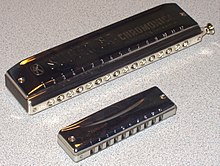Guitar/Harmonica and Guitar Combo
The harmonica is an instrument that has found favour with many guitarist. The idea evolved from the blues and country and western musicians of the early part of the 20th century. The role the harmonica plays in providing another timbre has appealed to many artists. Musicians such as Bob Dylan and Neil Young have used the combination to great effect.

Harmonicas exist in four varieties: diatonic, chromatic, tremolo and chord. The chromatic can play along to music in any key but is harder to master than the diatonic version. The diatonic harmonica is made to play in one key and is easier to learn but you will need to buy more than one. The guitar's natural key is E; so buying a diatonic harmonica in the key of E major would be ideal. The other diatonic harmonicas you should aim to add to your collection is G major and C major. Diatonic harmonicas are cheap and it shouldn't take long before you have a collection of harmonicas that cover every key. The tremolo harmonica is like a diatonic, yet it vibrates and has more vibrato than usual harmonicas. It is used for orchestra too.Chord harmonicas are very big and may require multiple people to play and can be even used in the orchestra at times.They add a touch to a lot of things really.Chord Harmonicas are very cool,yet very expensive too and they can run in the thousands when it comes to cost.Some good Chord Harmonicas can cost you $2,000 or more depending on the company selling them.

To play both instruments, one would need a way to hold the harmonica while the hands chord and strum the guitar. This is done by the harmonica holder, which goes around the neck, allowing the harmonica to be always in front of your mouth. However, there are a few things to keep in mind:
- Instead of moving the harmonica itself, you will now move your head in order to play the notes. Due to this limitation the solos you "blow" will be slower than if you had the harmonica cupped in your hands.
- Hand-related effects, such as hand vibrato, will be unavailable. Also, due to the lack of hands, there will be no additional resonance from the cupped hands.
Furthermore, since one is multitasking, it's best to know how to play both instruments individually very well, in order to spend less time trying to find each note and chord. When you buy your first harmonica, spend some time learning to play it with your hands. Try playing along to the recordings of Little Walter and Sonny Boy Williamson.
The harmonica will usually be played in the 2nd position (of course one can try other positions). Often the guitar plays the chords, while the harmonica provides the melody. This is because guitars have a much lower octave range than the harmonica; furthermore, guitarists can play chords in different keys easily. Since the harmonica is played in a higher pitch range, this makes it suitable for melodic lines. Another factor is the timbre of the harmonica tends to cut through the sound of resonating guitar chords. Still, this should not stop you reversing the roles, as long as it sounds pleasing.
It is possible to play chromatic harmonicas with a guitar. This can be done with the following:
- Valved Diatonic or XB-40
- Tombo S-50.
- Take off the mouthpiece of a straight tuned chromatic harp. However, one may need to make sure the body's edge is smooth
- Note: both S-50 and this method require using the lips to block the non-sounding row; S-50, due to greater distance between rows, is easier at this.
- Use the handless chromatic; essentially a special mouthpiece that move up and down between the rows, controlled by the movement of the head.